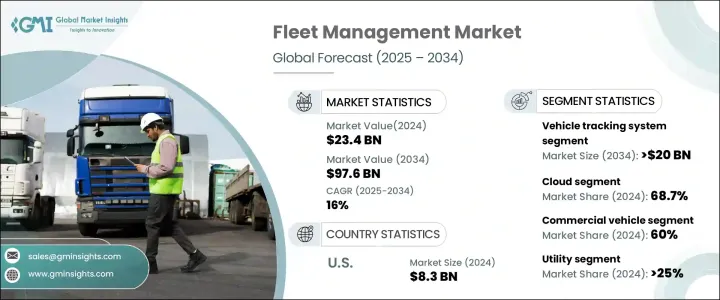
|
시장보고서
상품코드
1698574
세계의 플릿 관리 시장 - 기회, 성장 촉진요인, 산업 동향 분석, 예측(2025-2034년)Fleet Management Market Opportunity, Growth Drivers, Industry Trend Analysis, and Forecast 2025-2034 |
||||||
세계의 플릿 관리 시장은 2024년 234억 달러로 평가되었으며, 2025년부터 2034년까지 연평균 복합 성장률(CAGR) 16%로 성장할 것으로 예측됩니다.
이 확장은 전자상거래의 급성장과 라스트원 마일 딜리버리 서비스 수요 증가가 주요 요인입니다. 엄격한 차량 유지 보수 규제가 기업에 첨단 경영 관리 솔루션을 도입하도록 촉구하고 있습니다.

시장은 운전자 관리, 차량 추적 시스템, 운행 관리, 컴플라이언스 관리, 연료 관리, 유지 보수 관리, 자산 추적 등을 포함한 솔루션별로 구분됩니다. 차량의 상태와 경로를 실시간으로 모니터링하여 운용의 투명성을 높이고 연료 소비를 줄이고 차량의 가동 중지 시간을 최소화하기 위해 기업이 보안 및 규제 준수를 강화할 수 있습니다.
| 시장 범위 | |
|---|---|
| 시작 연도 | 2024년 |
| 예측 연도 | 2025-2034년 |
| 시작 금액 | 234억 달러 |
| 예측 금액 | 976억 달러 |
| CAGR | 16% |
배포 모델에 따라 시장은 클라우드 솔루션과 온프레미스 솔루션으로 분류됩니다. 클라우드 부문은 2024년 시장의 68.7%를 차지했습니다. 이러한 시스템은 확장성이 있어, 기업이 운용 필요에 따라 기능과 사용자 액세스를 쉽게 조정할 수 있습니다. 클라우드 서비스 제공업체가 시스템을 업데이트하고 유지 관리할 수 있기 때문에 기업은 IT 리소스를 다른 중요한 기능으로 되돌릴 수 있습니다.
시장은 또한 차량 유형별로 승용차와 상용차로 구분되며, 2024년 시장 점유율은 상용차가 약 60%를 차지했습니다. 물류, 전자상거래 및 라스트 마일 딜리버리 서비스에 대한 수요가 증가함에 따라 기업은 차량을 확장하고 첨단 추적 기술과 경로 최적화 기술을 통합하도록 촉구하고 있습니다. AI를 활용한 예지보전, 텔레매틱스, 실시간 추적은 기업이 성능을 최적화하면서 컴플라이언스를 개선하는 데 도움이 됩니다. 기업은 이러한 기술을 활용하여 연료 소비를 줄이고 차량 가동 중지 시간을 최소화하며 운전자의 안전을 강화하고 있습니다.
최종 용도별로, 시장은 운송 및 건설, 제조, 유틸리티, 헬스케어 및 의약품, 기타로 나눌 수 있습니다. 유틸리티 부문은 2024년 시장의 25% 이상을 차지합니다. 유틸리티 회사는 서비스의 신뢰성을 높이고 응답 시간을 개선하고 현장 작업을 최적화하기 위해 함대 관리 솔루션을 활용합니다. 실시간 차량 추적은 서비스 중단 시 기술자의 효율적인 파견을 가능하게 합니다. IoT 지원 추적 및 자동화는 자산 이용률과 유지 관리 스케줄링을 향상시킵니다. 예측 분석을 통해 보안 점검을 더욱 강화하고 비용이 많이 드는 고장으로 확장하기 전에 잠재적인 고장을 파악할 수 있습니다.
미국의 플릿 관리 시장의 2024년 시장 규모는 83억 달러를 넘어 지속가능성과 규제 준수에 대한 투자 증가가 그 요인이 되고 있습니다. 정부의 정책도 디지털 추적과 환경 친화적인 플릿 솔루션의 도입을 기업에 촉구하고 있습니다. 지속 가능한 관행에 대한 소비자의 기대 증가는 실시간 통찰을 제공하는 기술에 대한 투자를 기업에 촉구하고, 혁신을 촉진하고, 업계에서의 그린 테크놀러지의 채용을 촉진하고 있습니다.
목차
제1장 조사 방법과 조사 범위
- 조사 디자인
- 조사 접근
- 데이터 수집 방법
- 기본 추정과 계산
- 기준연도의 산출
- 시장추계의 주요 동향
- 예측 모델
- 1차 조사와 검증
- 시장 정의
제2장 주요 요약
제3장 업계 인사이트
- 생태계 분석
- 공급자의 상황
- 텔레매틱스 하드웨어 프로바이더
- 소프트웨어 개발 기업
- 무선 통신 사업자
- 시스템 통합자
- 플릿 관리 서비스 제공업체
- 이익률 분석
- 기술과 혁신의 전망
- 특허 분석
- 주요 뉴스와 대처
- 규제 상황
- 영향요인
- 성장 촉진요인
- 텔레매틱스와 IoT에 대한 수요 증가
- 엄격한 안전 및 배기 가스 규제
- E-Commerce와 라스트 원 마일 딜리버리의 성장
- 전기자동차와 자율주행차의 채용 확대
- 업계의 잠재적 위험 및 과제
- 데이터 과다와 관리상의 우려
- 드라이버 관리 및 안전성 문제
- 성장 촉진요인
- 성장 가능성 분석
- Porter's Five Forces 분석
- PESTEL 분석
제4장 경쟁 구도
- 소개
- 기업 점유율 분석
- 경쟁 포지셔닝 매트릭스
- 전략 전망 매트릭스
제5장 시장 추계 및 예측 : 솔루션별, 2021-2034년
- 주요 동향
- 운행 관리
- 드라이버 관리
- 차량 추적 시스템
- 컴플라이언스 관리
- 유지관리 관리
- 연료 관리
- 자산 추적
- 기타
제6장 시장 추계 및 예측 : 자동차 유형별, 2021-2034년
- 주요 동향
- 승용차
- SUV
- 해치백
- 세단
- 상용차
- 라이트 듀티
- 미디엄 듀티
- 헤비 듀티
제7장 시장 추계 및 예측 : 전개 모델별, 2021-2034년
- 주요 동향
- 클라우드
- 온프레미스
제8장 시장 추계 및 예측 : 최종 용도별, 2021-2034년
- 주요 동향
- 수송
- 건설
- 제조업
- 유틸리티
- 헬스케어 및 제약
- 기타
제9장 시장 추계 및 예측 : 지역별, 2021-2034년
- 주요 동향
- 북미
- 미국
- 캐나다
- 유럽
- 영국
- 독일
- 프랑스
- 스페인
- 이탈리아
- 러시아
- 북유럽
- 아시아태평양
- 중국
- 인도
- 일본
- 한국
- 뉴질랜드
- 동남아시아
- 라틴아메리카
- 브라질
- 멕시코
- 아르헨티나
- 중동 및 아프리카
- UAE
- 남아프리카
- 사우디아라비아
제10장 기업 프로파일
- ARI Fleet Management
- Element Fleet management
- Automile
- Azuga
- Bestmile
- ClearPath GPS
- Donlen Corporation
- Garmin
- Geotab
- GPS Insights
- NexTraq
- Omnitracs
- Orix
- Teletrac Navman
- Tourmaline Labs
- Trimble
- Utilimarc
- Verizon Connect
- Wheels
- Samsara
The Global Fleet Management Market was valued at USD 23.4 billion in 2024 and is projected to grow at a CAGR of 16% from 2025 to 2034. This expansion is largely driven by the rapid growth of e-commerce and increasing demand for last-mile delivery services. Companies are investing in real-time tracking, route optimization, and automation to enhance fleet performance and efficiency. Strict vehicle maintenance regulations are pushing businesses to adopt advanced fleet management solutions, as managing large fleets across multiple locations becomes increasingly complex. Regulatory constraints are compelling fleet operators to implement technologies that improve compliance while ensuring seamless operations.

The market is segmented by solutions, including driver management, vehicle tracking systems, operation management, compliance management, fuel management, maintenance management, asset tracking, and others. The vehicle tracking system segment is expected to surpass USD 20 billion by 2034. These systems provide security enhancements, optimize routes, monitor driver behavior, and facilitate predictive maintenance. Fleet operators rely on these systems to increase operational transparency, reduce fuel consumption, and minimize vehicle downtime. Real-time monitoring of vehicle conditions and routes allows businesses to prevent unauthorized usage while strengthening security and regulatory compliance.
| Market Scope | |
|---|---|
| Start Year | 2024 |
| Forecast Year | 2025-2034 |
| Start Value | $23.4 Billion |
| Forecast Value | $97.6 Billion |
| CAGR | 16% |
Based on the deployment model, the market is categorized into cloud and on-premises solutions. The cloud segment accounted for 68.7% of the market in 2024. Cloud-based fleet management solutions eliminate the need for upfront investment in hardware and software, making them cost-effective for businesses of all sizes. These systems offer scalability, allowing companies to easily adjust features and user access based on operational needs. With cloud service providers handling system updates and maintenance, businesses can reallocate internal IT resources to other critical functions. The ability to access fleet management tools remotely enables managers to monitor and control operations from any location, ensuring seamless decision-making and efficiency.
The market is also segmented by vehicle type into passenger vehicles and commercial vehicles, with the commercial segment holding around 60% of the market share in 2024. Increased demand for logistics, e-commerce, and last-mile delivery services is prompting businesses to expand their fleets and integrate advanced tracking and route optimization technologies. AI-powered predictive maintenance, telematics, and real-time tracking help companies improve compliance while optimizing performance. Businesses are leveraging these technologies to reduce fuel consumption, minimize vehicle downtime, and enhance driver safety.
By end use, the market is divided into transportation and construction, manufacturing, utility, healthcare and pharmaceuticals, and others. The utility segment held over 25% of the market in 2024. Utility firms utilize fleet management solutions to enhance service reliability, improve response times, and optimize field operations. Real-time vehicle tracking enables efficient dispatching of technicians during service disruptions. IoT-enabled tracking and automation improve asset utilization and maintenance scheduling. Predictive analytics further enhance security checks, identifying potential failures before they escalate into costly breakdowns.
The U.S. fleet management market was valued at over USD 8.3 billion in 2024, fueled by growing investments in sustainability and regulatory compliance. Companies are adopting advanced fleet technologies to lower emissions, enhance transparency, and streamline operations. Government policies are also encouraging businesses to implement digital tracking and eco-friendly fleet solutions. Rising consumer expectations for sustainable practices are driving businesses to invest in technologies that offer real-time insights, fostering innovation and promoting green technology adoption in the industry.
Table of Contents
Chapter 1 Methodology & Scope
- 1.1 Research design
- 1.1.1 Research approach
- 1.1.2 Data collection methods
- 1.2 Base estimates and calculations
- 1.2.1 Base year calculation
- 1.2.2 Key trends for market estimates
- 1.3 Forecast model
- 1.4 Primary research & validation
- 1.4.1 Primary sources
- 1.4.2 Data mining sources
- 1.5 Market definitions
Chapter 2 Executive Summary
- 2.1 Industry 3600 synopsis, 2021 - 2034
Chapter 3 Industry Insights
- 3.1 Industry ecosystem analysis
- 3.2 Supplier landscape
- 3.2.1 Telematics hardware providers
- 3.2.2 Software developers
- 3.2.3 Wireless carriers
- 3.2.4 System integrators
- 3.2.5 Fleet management service providers
- 3.3 Profit margin analysis
- 3.4 Technology & innovation landscape
- 3.5 Patent analysis
- 3.6 Key news & initiatives
- 3.7 Regulatory landscape
- 3.8 Impact forces
- 3.8.1 Growth drivers
- 3.8.1.1 Rising demand for telematics & IoT
- 3.8.1.2 Stringent safety & emission regulations
- 3.8.1.3 Growth in e-commerce & last-mile delivery
- 3.8.1.4 Growing adoption of electric & autonomous vehicles
- 3.8.2 Industry pitfalls & challenges
- 3.8.2.1 Data overload and management concerns
- 3.8.2.2 Driver management and safety issues
- 3.8.1 Growth drivers
- 3.9 Growth potential analysis
- 3.10 Porter's analysis
- 3.11 PESTEL analysis
Chapter 4 Competitive Landscape, 2024
- 4.1 Introduction
- 4.2 Company market share analysis
- 4.3 Competitive positioning matrix
- 4.4 Strategic outlook matrix
Chapter 5 Market Estimates & Forecast, By Solution, 2021 - 2034 ($Bn)
- 5.1 Key trends
- 5.2 Operation management
- 5.3 Driver management
- 5.4 Vehicle tracking system
- 5.5 Compliance management
- 5.6 Maintenance management
- 5.7 Fuel management
- 5.8 Asset tracking
- 5.9 Others
Chapter 6 Market Estimates & Forecast, By Vehicle Type, 2021 - 2034 ($Bn)
- 6.1 Key trends
- 6.2 Passenger vehicles
- 6.2.1 SUV
- 6.2.2 Hatchback
- 6.2.3 Sedan
- 6.3 Commercial vehicles
- 6.3.1 Light-duty
- 6.3.2 Medium-duty
- 6.3.3 Heavy-duty
Chapter 7 Market Estimates & Forecast, By Deployment Model, 2021 - 2034 ($Bn)
- 7.1 Key trends
- 7.2 Cloud
- 7.3 On-premises
Chapter 8 Market Estimates & Forecast, By End Use, 2021 - 2034 ($Bn)
- 8.1 Key trends
- 8.2 Transportation
- 8.3 Construction
- 8.4 Manufacturing
- 8.5 Utility
- 8.6 Healthcare & pharmaceuticals
- 8.7 Others
Chapter 9 Market Estimates & Forecast, By Region, 2021 - 2034 ($Bn)
- 9.1 Key trends
- 9.2 North America
- 9.2.1 U.S.
- 9.2.2 Canada
- 9.3 Europe
- 9.3.1 UK
- 9.3.2 Germany
- 9.3.3 France
- 9.3.4 Spain
- 9.3.5 Italy
- 9.3.6 Russia
- 9.3.7 Nordics
- 9.4 Asia Pacific
- 9.4.1 China
- 9.4.2 India
- 9.4.3 Japan
- 9.4.4 South Korea
- 9.4.5 ANZ
- 9.4.6 Southeast Asia
- 9.5 Latin America
- 9.5.1 Brazil
- 9.5.2 Mexico
- 9.5.3 Argentina
- 9.6 MEA
- 9.6.1 UAE
- 9.6.2 South Africa
- 9.6.3 Saudi Arabia
Chapter 10 Company Profiles
- 10.1 ARI Fleet Management
- 10.2 Element Fleet management
- 10.3 Automile
- 10.4 Azuga
- 10.5 Bestmile
- 10.6 ClearPath GPS
- 10.7 Donlen Corporation
- 10.8 Garmin
- 10.9 Geotab
- 10.10 GPS Insights
- 10.11 NexTraq
- 10.12 Omnitracs
- 10.13 Orix
- 10.14 Teletrac Navman
- 10.15 Tourmaline Labs
- 10.16 Trimble
- 10.17 Utilimarc
- 10.18 Verizon Connect
- 10.19 Wheels
- 10.20 Samsara



















